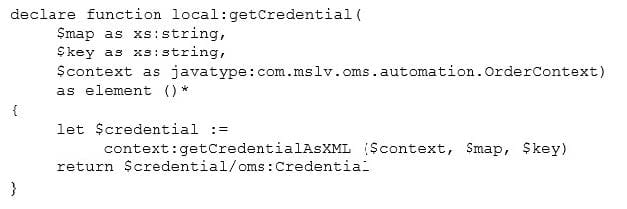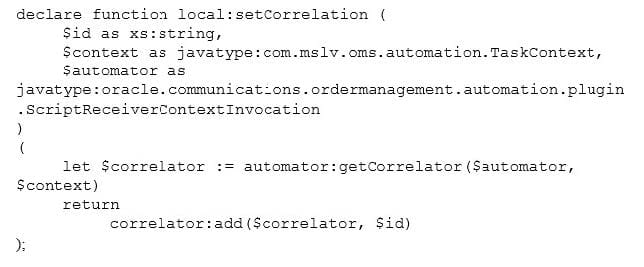1Z0-493 Online Practice Questions and Answers
The following function is called in an XQuery automation plug-in before performing a logic that you have developed. Identify the functional action that would be executed with the output of this code.

A. Authenticate with a southbound interface.
B. Receive responses from a JMS queue.
C. Publish messages to a JMS queue.
D. Communicate with another running order in the same OSM instance.
E. Check the users that are running tasks in the current order.
You are commissioned to include a new action in the Task Web client context menu that appears when a user right-clicks the worklist and that interacts with selected tasks. How would you include this requirement?
A. by adding the new action to a task in Design Studio
B. by configuring the oms-config.xml file
C. by adding the new action to an order in Design Studio
D. by deploying a custom Java code
E. by ideating the Task Web client source code
You are configuring WebLogic resources for an instance of OSM that connects to a billing application that is deployed in another WebLogic domain and that receives new messages in its local JMS queue. Which two statements are true about a possible procedure to connect OSM to this billing application?
A. You can create and use Store and Forward (SAF) resources to connect the OSM and billing queues.
B. You can configure the properties of the automation plug-in in OSM that allows connection to remote queues.
C. OSM local queues do not need any special configuration to be connected to remote queues.
D. OSM and the billing application must be deployed on the same WebLogic Server, so that OSM can write directly in the billing application queue.
E. OSM offers a productized Python script that recovers messages from the OSM local queue and inserts them in the billing application queue.
Which three aspects can you ascertain by analyzing an orchestration plan in the Order Management Web client?
A. You can find the order items that are associated with each fulfillment function.
B. You can identify the order components that will be executed in parallel.
C. You can identify the order components that will be executed at the beginning of order execution.
D. You can identify the fulfillment mode associated with an order.
E. You can define the dependency conditions between order components.
You have a product specification that has an order component called Provisioning. You are now required to select order items to be included in this order component by implementing a condition that is based on order item properties. Consider that you do not want to impact other product specifications that also use the Provisioning function, that the decomposition rules apply to all product specifications, and that you do not want your logic to be dependent on the product specification name.
Given this scenario, where would you define the condition logic?
A. in the existing decomposition rule condition
B. in the product specification order component condition
C. in the orchestration stage order component condition
D. in the order item specification orchestration condition
E. in the orchestration plan dependencies condition
Identify two approaches that you should follow in your OSM design in order to support multiple versions of cartridges.
A. When there are multiple versions of a cartridge with multiple versions of an order, order recognition rules must be modeled to recognize a specific version of the order instead of the default version.
B. When there are multiple versions of a cartridge with multiple versions of an order, a single order recognition rule should be modeled to recognize all order versions.
C. To recognize a specific version of an order, the Target Order version of the order recognition rule should be set to the revision of the cartridge where the specific version of the order resides.
D. Multiple versions of orders are supported when modeling cartridges in Design Studio, but only one version of an order should be deployed at the same time in a running environment.
E. When deploying a new version of an existing cartridge, the new version of the orders should be compliant with the old version, because orders will be automatically migrated to the newer version.
Which two functions are available in the XML Import/Export tool that you could use when developing with OSM?
A. import and export of metadata
B. deployment of cartridges to Oracle WebLogic Server
C. change in the severity of log levels
D. configuration of WebLogic resources
E. purging of metadata and order data
One of your client's requirements involves enrichment of an order received from a CRM system with a customer geographic region that can be retrieved by using a web service interface. Considering that the order cannot be created without this information, which development approach would you propose to meet this requirement?
A. adding a data instance to the order data rule transformation of the corresponding recognition rule
B. adding a data instance to the order priority transformation of the corresponding recognition rule
C. adding a data instance to the order reference transformation of the corresponding recognition rule
D. adding a data instance to the recognition rule XQuery of the corresponding recognition rule
E. adding a data instance to the validation rule XQuery of the corresponding recognition rule
A CustomerContact data element is set as a significant element in your data dictionary, whereas it is set as non-significant in your order template. During the execution of an order, a revision is submitted that modifies only the CustomerContact information. Identify the impact of this data change on a task that has CustomerContact with no extra configuration as part of its task data.
A. The task is re-executed with no value in CustomerContact.
B. The task is re-executed with a new CustomerContact value.
C. The task is re-executed with the old CustomerContact value.
D. The task is re-executed with both the new and the old CustomerContact values.
E. The task is not re-executed.
You have an OSM system that has been configured with the default parameters recommended in the OSM documentation, but the Task Web client users report that the OSM system is slow. Which three actions would you take?
A. Verify the amount of memory being allocated by checking the max memory configuration in the Oracle WebLogic Server startup script on the workstation where you have deployed OSM.
B. Check whether the Task Web client user is selecting buttons, menu options, or tasks multiple times when experiencing lags between requests and responses.
C. Verify the number of database connections.
D. Re-install OSM in case the system responds slowly during any operations executed.
E. For slow Worklist access, check the number of flexible headers configured in the Worklist.
An enterprise customer requests a high-speed broadband service at three different office locations, which are indicated in three CustomerAddress structures in the order data. This requires three requests to be submitted to the activation system to activate services at the three locations.
Considering a process-based order, which is the most efficient process modeling approach to send as many requests to the activation system as the CustomerAddress structures present in your order?
A. Configure a single task that sends a request to the activation system with a Pivot Node based on the CustomerAddress structure.
B. Configure a counter in your order data and a loop in the process flow, such that the task is executed as many times as the CustomerAddress structures present in the order.
C. Configure an XQuery in a task that sends a request to the activation system to publish as many messages as the CustomerAddress structures present in the order.
D. Design the process, including as many tasks that send a request to the activation system as the maximum number of CustomerAddress structures.
E. configure an XQuery in a task that sends a request to the activation system by setting CustomerAddress as the multi-instance indicator in the task context.
Identify the option with the scenario or scenarios that can be implemented in the context of task permissions.
1.
The ActivateDSL Role, which requires normal processing of an activation task, requires permission to execute this task under the "DO" execution mode.
2.
The OrderFulfillment Role, which needs to roll back the activation operations previously performed by an activation task, requires permission to execute this task only under the "Amend DO" and "UNDO" execution modes.
3.
The InventoryUpdate Role, which executes reassignment of resources in the inventory system by re-executing a previously performed task in an order under revision, requires permission to execute this task
only under the "REDO" execution mode.
A. 1
B. 2
C. 3
D. Both 1 and 2
E. Both 2 and 3
F. Both 1 and 3
What is the possible reason for calling the following XQuery function from an automation?

);
A. to set a correlation ID in the context of a task that receives responses from a supply chain system
B. to set a correlation ID in the context of a task that sends requests to an activation system
C. to set a correlation ID in the context of an order received from a CRM system
D. to set a correlation ID in the context of a notification that sends updates back to a CRM system
E. to set a correlation ID in the context of a task that sends requests to and receives responses from an inventory system
You are requested to design a solution to handle a fallout scenario while communicating with an inventory system for resource allocation because there are no available ports for a product that was purchased. Identify a solution that would address this condition.
A. designing OSM to update the CRM system about the failure, so that the customer service representative (CSR) can decide whether to cancel the in-flight order or issue a new revision order to allocate new ports
B. cancelling the order in OSM and informing the customer that the request cannot be processed
C. reallocating the reserved ports in the inventory system and activating the requested ports in the activation system manually
D. suspending the in-flight order in OSM and manually creating a new order to create new ports in the inventory system
E. using the Task Web client to edit the order, manually changing the data received from the CRM system, and retrying the failed task for proper allocation of new ports
A customer purchases ABC service for which a new order is submitted to Order Service Management (OSM). Activation for this service is under execution, indicating that the point-of-no-return has not yet been reached, when the customer decides to change the ABC service to XYZ service.
Which two OSM features can you use to handle the customer's request?
A. Order Change Management
B. Order Fallout Management
C. Future-dated orders
D. Follow-on orders
E. Creation of new orders
